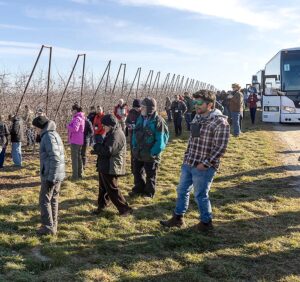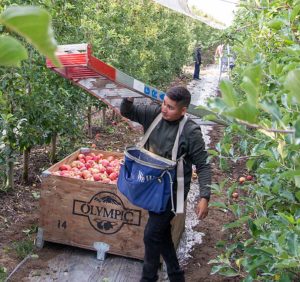
Of all the challenges facing the fruit industry, labor and retail trends rank high on the list.
Speakers addressed those topics during the International Fruit Tree Association’s 66th annual conference in Grand Rapids, Michigan, in February, during a session dedicated to future challenges.
John Woodall, a regional account manager for the Michigan Apple Committee, discussed the changing retail climate, driven by changing technology and consumer expectations.
Consumers expect a lot these days. They want retailers to lower their carbon footprint, source products sustainably and reduce waste across the entire supply chain. But their most significant expectation for the apple industry might be a growing demand for local produce, which is having a marked effect on sales trends, logistics and transportation patterns, Woodall said.
Consumers want to know where their food is coming from, and suppliers should be prepared with high-quality photos, write-ups about their operations and products that retailers can use in their marketing materials, he said.
Another significant trend: Manufacturers and brands are shifting more toward direct-to-consumer sales, which helps them control quality and price but leaves retailers out of the equation. Even PepsiCo has launched a website, called Snacks.com, to sell its snack products directly to consumers.
Changing technological trends are also reshaping retail sales. Artificial intelligence can track inventories, purchases and overall customer shopping patterns. Retailers will be able to use that information to promote customer engagement and education. And one day, we might see robots doing inventory in the grocery aisle, or even drones flying around stores to quickly identify out-of-stock or misplaced items, he said.
Woodall stressed that growers must keep a close relationship with their customers, figure out how they use technology, and monitor their shopping patterns. In other words: Stay engaged.
“You have to stay on top of the trends and capitalize while they’re here, because the new trend is right around the corner,” Woodall said.
Labor
Michigan State University economics professor Zach Rutledge discussed shifting labor trends.
The dwindling supply of farmworkers in the United States is forcing growers to seek alternatives.
There are many reasons for the decline in farm labor: The domestic workforce is aging, workers are finding other opportunities in nonfarm sectors, and the number of laborers following the crop migration has declined significantly in the past 20 years.
Rutledge said about 70 percent of U.S. farm labor is foreign-born. Of those foreign-born workers, 90 percent are from Mexico. For the first time in recent history, the number of Mexican immigrants to the United States declined in the past decade. Part of that is due to tighter border security, but much is due to lower birthrates in Mexico.
In a survey, Rutledge asked farmers whether they were able to hire all the workers they wanted to hire during 2020 or 2021. Of the roughly 1,300 participants, over half said they were unable to hire all the workers they wanted at some point during that period. The average shortage was about 20 percent.
About 64 percent of respondents said the COVID-19 pandemic worsened their labor shortages. The need for personal protective equipment, cleaning and sanitizing, and social distancing measures also added to their labor costs.
Growers are dealing with the labor shortage in different ways. They’re raising wages to attract and retain workers, investing in labor-saving technologies, utilizing farm labor contractors, making cultivation and management practices more efficient and hiring more H-2A workers, Rutledge said.
Despite the fact that the H-2A foreign guest-worker program is complicated and expensive, its use has expanded rapidly over the past decade.
The U.S. Department of Labor certified 371,619 H-2A positions in 2022. More than 15,000 of them worked in Michigan — mostly at specialty crop farms on the western side of the state.
Rutledge said about half of Michigan’s H-2A workers are hired directly by growers. The other half work for farm labor contractors.
Rutledge also surveyed growers about the ways they recruit and retain employees. The top incentives were offering a flexible schedule, health insurance and production bonuses.
—by Matt Milkovich








Leave A Comment